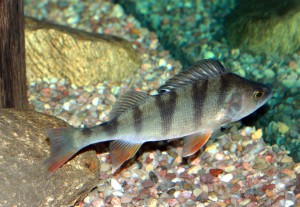 One of the most common fish, the European perch is spread in Europe (except for Spain, Italy and Northern Scandinavia), in Asia, and across Russia.
One of the most common fish, the European perch is spread in Europe (except for Spain, Italy and Northern Scandinavia), in Asia, and across Russia.
The perch inhabits different types of water bodies: lakes, water reservoirs, rivers, running ponds and brackish lakes – even in a few mountain lakes at 1000-m altitude. Perches have pretty and vivid coloration: the dark green back, the greenish yellow sides are crossed by 5-9 dark lateral bars, the caudal, anal, and pelvic fins are magenta-colored, whereas the pectoral fins are yellow. The first dorsal fin is graying blue with a large black spot in the rear, and the second one is greenish yellow. Their eyes are orange. However, the coloration in perches changes water to water, and so in the forest peaty lakes they come uniformly dark. In the Pskov-PeipsiLake the perch forms eco-morphs adapted to its various parts: one morph is the smallish littoral, grassy perch; another one is the morph of the deep. The grassy perch grows slowly, with a great share of zooplankton and insect larvae in its diet. The deep perch is a fast-growing predator reaching significant sizes – the largest may be 40 cm long, weighing 2 kilos. Alongside with this, they become hump-backed, since they grow wider and thicker, rather than longer. Perches mature early: males after years 1-2, females – year 3 and later. They spawn in the water of 7-8 to 15°С, in the waters of the в temperate zone, right after pikes. The eggs are laid onto the last year’s vegetation, snags, roots, willow twigs and even soil proper. The batch appears as a hollow meshy tube of gel, with cellular walls. Eggs are planted by 2-3 on each side of the cell. Every developing egg is 3.5 mm. The batches stuck to the various objects under water resemble lacy ribbons. The length and breadth of the lacy batch depends on the size of the female. With smaller ones, it fluctuates between 12 and 40 cm, and with larger ones it may be 1 m and more. In the littoral zone multiple short batches are more frequent, yet in some sites sometimes many large batches can be encountered. But most often, the large batches are laid in the deep.
Females, depending on their size, lay 12 to 200-300 and even 900 thousand eggs. In the first year, the perch fry stick predominantly to the littoral zone feeding on zooplankton in thickets. Though perches can go rapacious quite early – when 4 cm long, usually it happens at the length of 10 cm. The most predaceous period comes in the late summer, when numerous growing fish fry become plentiful and accessible prey. The perch readily eats its young. It is more voracious than the pike: 1 kg of perch flesh takes 4.9 kg of other fish, whereas per 1 kg of pike it is 3.5 kg. Due to the wide spread and high numbers, perches are easy prey for many fish. Sheatfish, pikes, pikeperch and burbot willingly hunt them. Gulls, terns and ospreys also attack them. The commercial haul of perch is substantial, comprising half the catch in some lakes. It is a major commercial fish of the Pskov-PeipsiLake.
/ * The photos at lake.peipsi.org are cross-posted from commons.wikimedia.org and are used for familiarization purposes only. No commercial use of the photos is allowed. For more information about to use the photos see the originals on commons.wikimedia.org. /


